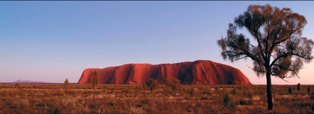Aboriginal place names and dual naming
The Aboriginal place names and dual naming policy PDF (1.3 MB) outlines how Aboriginal names can be applied to places in the Northern Territory (NT), as follows:
- Registration of recognised Aboriginal place names for geographic and topographic features where there is no officially registered name.
- Naming or dual naming of geographical or topographical features, if there is a registered or recorded name in place.
- Aboriginal names for new places (if appropriate) which can include:
- commemoration of the contributions or achievements of an Aboriginal person,
- names that are used by and/or agreed by Aboriginal people to describe a particular area
- names that are derived from Aboriginal language words.
It is the Place Names Committee’s preference that requests to name new roads, suburbs, parks, infrastructure and buildings first consider an Aboriginal name and requestors engage and collaborate with relevant local Aboriginal organisations to identify if there is an appropriate Aboriginal name that can be used.
However, it may be appropriate and practical to apply non-Aboriginal place names in existing area (i.e. infill land developments or existing/staged subdivision) particularly where thematic naming has already been used.
Improving information about processes
In 2019, the Department of Infrastructure, Planning and Logistics (DIPL) hosted Aboriginal Place Names forums in Alice Springs, Katherine and Darwin to hear from the community about the opportunities and challenges for Aboriginal place naming in the NT.
Read the consultation's outcomes report PDF (1.0 MB).
DIPL is working to strengthen engagement processes for place naming, particularly for dual and Aboriginal place names. Feedback from the forums is being considered in the development of an engagement framework that will guide people making place names requests to understand who and how to engage relevant stakeholders.
What is a ‘dual name’?
In the NT, generally a dual name has 2 distinct parts separated by a solidus (/); one is an Aboriginal name and the other is a non-Aboriginal name, such as the name given and recorded by an explorer since English settlement.
Dual names are generally only applied to geographic and topographic features and some parks.
To avoid potential confusion for emergency services such as police, fire and ambulance and other service providers, dual naming is not supported for any place name that forms part of an address such as:
- roads
- suburbs
- localities
- towns/communities.
History of dual naming in the Territory
The NT was the first Australian jurisdiction and a world leader in officially incorporating dual naming in its naming practices and approving dual names for geographic features.
The most well-known example is Uluru/Ayers Rock.
Uluru/Ayers Rock
In 1873, Ayers Rock (and Mount Olga) were named by the South Australian Government (recorded in South Australian Parliamentary Paper 48 of 1873).
Since 1894, the names Uluru (and Kata Tjuta) in varying forms have been recorded, though not as widely as their English name equivalents.
On 15 December 1993, the first official dual named feature in the NT was registered - Ayers Rock/Uluru.
In 2002, following a request from the Regional Tourism Association in Alice Springs, the order of the dual names was officially changed to Uluru/Ayers Rock.
Read more about Uluru/Ayers Rock in the Place Names Register.

Give feedback about this page.
Share this page:
URL copied!